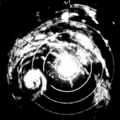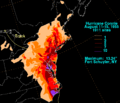Hurricane Connie facts for kids
Hurricane Connie was a very powerful hurricane that hit the Mid-Atlantic states and North Carolina in August 1955. It caused a lot of damage and flooding. Because of how much destruction it caused, the name Connie was later removed from the list of hurricane names, meaning it would never be used again for another storm.
Contents
What Was Hurricane Connie?
Hurricane Connie was a major storm that formed in the Atlantic Ocean in August 1955. It grew very strong, reaching Category 4 on the Saffir–Simpson hurricane wind scale. This means it had very fast winds, over 130 miles per hour! It was one of two big hurricanes that hit the East Coast of the United States that year, with Hurricane Diane following right after.
How Did Hurricane Connie Form?
Connie started as a tropical wave near the Cape Verde Islands off the coast of Africa. It slowly moved west across the Atlantic, getting stronger as it went. By August 5, it had become a tropical storm, and by August 6, it was a full-blown hurricane. It kept getting stronger, becoming a major hurricane by August 7.
Where Did Hurricane Connie Go?
Connie moved towards the Bahamas and then turned north. It passed close to North Carolina and then moved up the coast, affecting states like Virginia, Maryland, Delaware, New Jersey, Pennsylvania, and New York. Even though it weakened a bit before making landfall, it still brought a lot of rain and strong winds to these areas.
Connie's Path and Landfall
The hurricane first made landfall near Morehead City, North Carolina, on August 12. By then, it had weakened to a Category 1 hurricane, but it was still very dangerous. After hitting North Carolina, it moved inland and slowly lost its strength, eventually becoming a tropical storm and then a tropical depression as it moved over Canada.
What Damage Did Hurricane Connie Cause?
Hurricane Connie caused widespread damage, mainly from heavy rainfall and flooding. Many areas received over 10 inches (250 mm) of rain. This led to rivers overflowing their banks and causing severe floods in towns and cities.
Flooding and Power Outages
The heavy rains from Connie caused major flooding, especially in the Mid-Atlantic states. Homes, businesses, and roads were flooded, making it hard for people to travel. Many areas also lost electricity because strong winds knocked down power lines. Farmers lost crops, and many boats were damaged along the coast.
Impact on People
Sadly, Hurricane Connie was responsible for several deaths, both directly from the storm and indirectly from accidents related to the storm's aftermath. Thousands of people had to leave their homes to escape the floods. The total damage from Connie was estimated to be around $86 million in 1955, which would be much more today.
Why Was the Name Connie Retired?
Hurricane names are retired when a storm causes so much damage or so many deaths that using the name again would be insensitive. Because Hurricane Connie caused significant destruction and loss of life, the name "Connie" was officially retired by the World Meteorological Organization. This means no future Atlantic hurricane will ever be named Connie.
Images for kids
See also
 In Spanish: Huracán Connie (1955) para niños
In Spanish: Huracán Connie (1955) para niños




